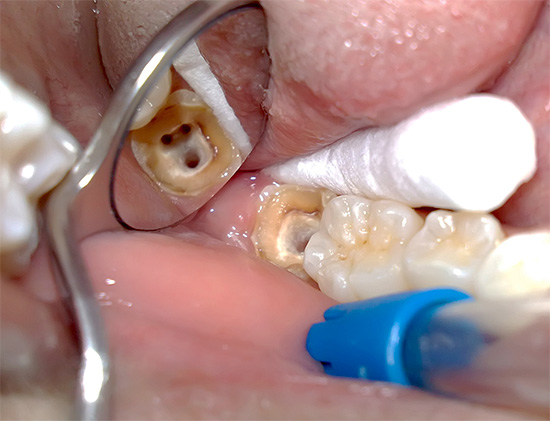
Most people seek emergency help from a dentist just for the simple reason that they did not pay enough attention to caries, considering it to be a kind of “annoying misunderstanding” that could wait until there was free time for his treatment. As a result, the most common cause of acute pain is no longer caries, but pulpitis, which is associated with damage to the soft tissue inside the tooth. And often the symptoms of pulpitis continue to be confused with caries, hoping to once again wait or drown out the pain with painkillers.
But the defeat of the pulp chamber of the tooth is still far from the limit. The result of excessive “long-suffering” is often the transition of pulpitis to the more difficult to treat diseases - periodontitis. Often the outcome of the complications of pulpitis is the removal of a tooth, after which the neighboring teeth can shift, bite violation, normal chewing of food can occur,and sometimes - diseases of the stomach and intestines.
The photo below shows a tooth in which deep caries led to the development of pulpitis:
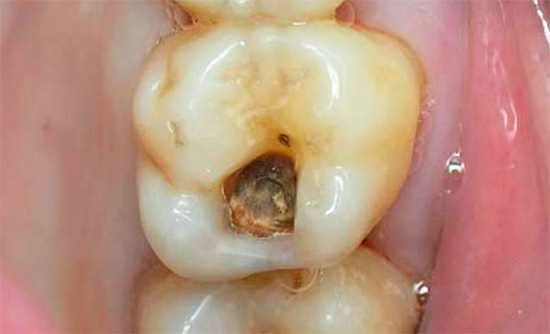
Many people know firsthand about the possible appearance of the so-called "flux" (periostitis). But few people know that the flux on the gum often appears after long pulpic pains and is the result of the dying off of the “nerve” in the dental canal with the formation of pus, which simply has no place to go out, and therefore it goes towards the root of the tooth, inflating the gum.
Over time, flux can turn into a fistula (see photo):
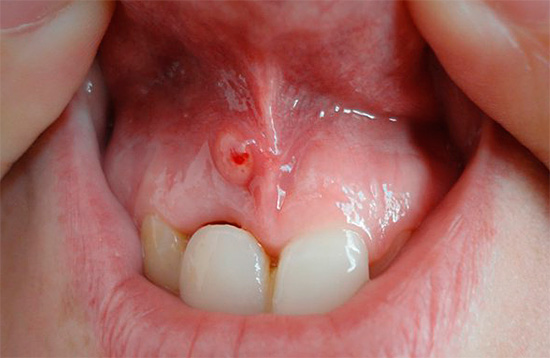
What is pulpitis, what are the causes of its occurrence, how it can threaten human health and what types of this pathology are - all of this will be discussed further.
It is interesting
About the pain that can occur when exposed to the "nerve" of the tooth, they knew long before the advent of modern dentistry. At the time of the Inquisition, the first primitive hand tools (something like dental machines) were used for torture, which, while rotating, crush enamel and dentine and reach the soft tissues inside the tooth, thereby causing their irritation and destruction.
Of course, everything was done in order to cause unbearable pain in the subject, and it came down to loss of consciousness and pain shock.Then the sufferer was brought to life in order to continue exposure to the pulp. Sometimes torture lasted more than one day, and the person died from traumatic shock.
So what is pulpit?
Pulpitis is an inflammatory reaction of the pulp tissue (dental “nerve”) that occurs in response to an irritating factor, external or internal. Pulp is a soft tissue penetrated by vessels and nerves. There are a lot of nerve cells inside it, which is why toothache is considered one of the strongest.
Photos of tooth pulp:
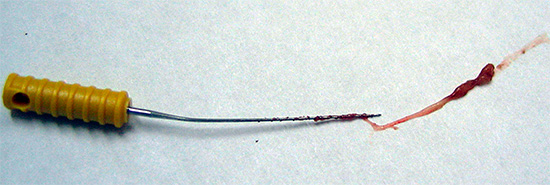
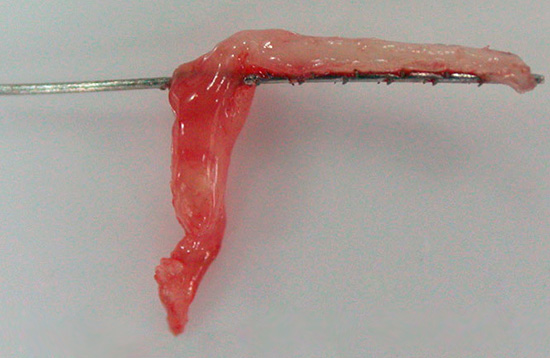
Why, when pulpitis occurs so much pain?
Due to the fact that the inflammatory reaction has a phase of edema, during the increase in pulp size, nerve cells are squeezed with the development of severe unbearable pain. At acute forms of pulpitis the pulp is closed with a thin layer of carious tissues, and in chronic forms, when the pain is not so pronounced, most often the bottom of the carious cavity communicates with the pulp chamber. In such cases, the pain is aching in nature and becomes pronounced only when irritants get into the "hollow" of the tooth (hot, sharp), or due to complete blockage of the opening over the pulp with something (seeds, nuts, apples).
As a result of swelling and compression of the entire connective tissue bundle, gradual necrosis (death) of the “nerve” occurs.
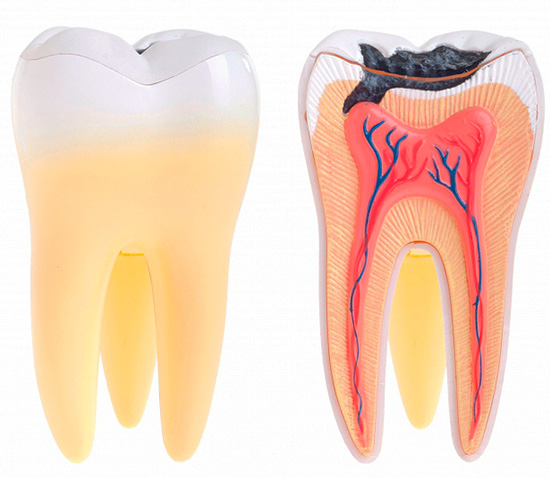

With one of the forms chronic pulpitis only the coronal part of the tissue dies, and in the canals it partially remains alive.
Causes of pulpitis
The most common cause (etiology) of pulpitis is deep caries. In the process of deepening the cavity, there is a direct or indirect penetration of microbes into the pulp tissue. With direct access, the infection falls directly on the exposed pulp, and indirectly through dentinal tubules penetrating the thickness of the dentin.
In dentistry, there are several ways to infect the pulp and the occurrence of pulpitis:
- through the crown of the tooth (caries complication)
- through the hole of the root apex with the manifestation of retrograde pulpitis.
Retrograde form of pulpitis is rare because of its specific developmental mechanism (pathogenesis). Causes of retrograde pulpitis are:
- Hematogenous (through the blood) infection of the tooth pulp with common infectious diseases (influenza, rubella, etc.), when the infection spreads to the maxillofacial region.
- With the spread of infection from the infectious foci close to the roots of the tooth, which most often become the maxillary sinus with sinus.
- Through an infected periodontal pocket (the space between the root and gum), when, due to a violation of the periodontal attachment, the infection rushes to the apex of the tooth root, causing pulpitis.
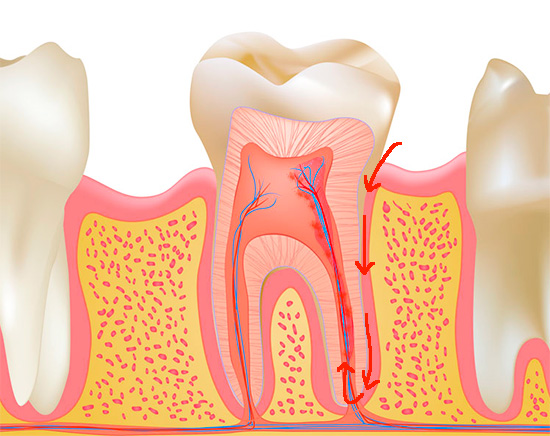
Also one of the most common causes of the development of pulpitis are mistakes of the doctor or his incorrect actions. Most often this is due to overheating of the tooth during its processing (preparation), accidental opening of the pulp chamber, followed by the imposition of a permanent seal, as well as improper turning of the tooth under the crown with non-compliance with the technique and without manufacturing protective caps after the procedure. A pulping tooth begins to manifest itself immediately or after medical error, often forcing the doctor to redo all the work anew.
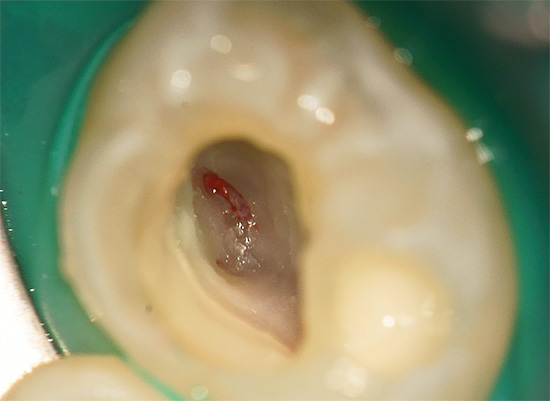
It is interesting
One of the rarest pulpitis is traumatic and pulp calculitis. Trauma upon impact, injury, or fall is most often characteristic of the front teeth: it is in such cases that pulpitis has a non-infectious origin.The symptoms of pulpitis of the front teeth arising from this do not differ in any way from the “classical” variants of the development of pathology.
When calculi pulpitis in the dental "nerve" there are disturbances due to denticles and petrification - sediments consisting of salts (mainly calcium compounds). These calcified calculi compress the delicate tissue of the pulp, causing the development of pulpitis.
The following picture schematically shows the classic version of the development of pulpitis - after deep caries:

Acute and chronic course of the disease
Pulpitis of a tooth, as a disease, can have several currents: acute, chronic and in the acute stage. Most often, first formed acute pulpitis, and then - chronic. At some point in time, the chronic form goes into an exacerbation stage.
However, this scheme does not apply to all cases: it also happens that the tooth does not sharply hurt, and the pathology immediately turns into a sluggish chronic form. Often, a person does not even have exacerbations, when the chronic form of pulpitis smoothly changes into another more complicated disease for the treatment - periodontitis.
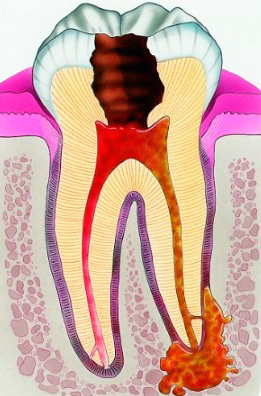
The pathogenesis (development) of pulpitis is directly related to the etiology (cause) of its occurrence and may have its own specifics, however, any inflammatory tissue reaction has much in common. Regardless of what causes pulpitis (infection, trauma, or toxic effects on the “nerve” of the filling material), serious structural changes occur inside the pulp tissue:
- pulp edema;
- impaired blood flow;
- oxygen starvation of cells;
- the difficulty of the removal of toxins;
- phenomena of necrosis (death).
Among the acute pulpitis emit focal and diffuse. In both cases, pulping tooth hurts not only spontaneously without irritants, but also in the presence of them (sweet, cold, etc.). Characterized by night shooting pains and small intervals between attacks, when a person does not feel pain.
Difference of acute diffuse pulpitis from focal is the spread of pain along the branches of the trigeminal nerve: the pain can be given to the temple, ear, infraorbital region, the back of the head, cheekbone, etc. In such cases, the person can not accurately specify the doctor causing the suffering of the tooth, and have to use additional diagnostic tools.
In case of focal pulpitis, pain is localized in one particular tooth, and the patient is able to point precisely at it.
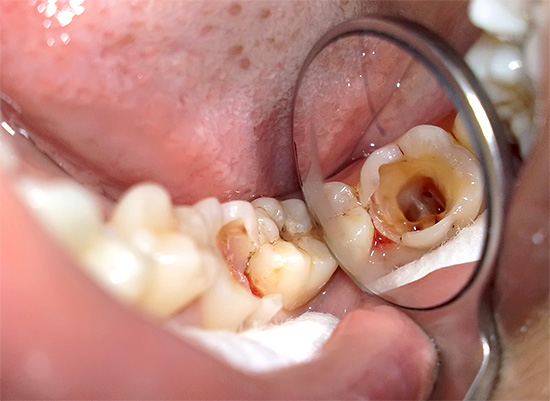
The consequences of irreversible disturbances in the dental pulp can be chronic forms of pulpitis: fibrous, gangrenous and hypertrophic. The names themselves speak for themselves:
- at fibrous pulpitis inflamed nerve tissue degenerates into fibrous tissue;
- at gangrenous - there is gangrene or necrosis of the coronal or partially root tissue inside the tooth;
- in hypertrophic pulpitis, hypertrophy (proliferation) of soft tissue occurs, which can often occupy the entire carious cavity, the so-called “wild meat”.

Chronic pulpitis usually manifests itself only with aching pains and weak sensitivity from stimuli (especially hot). Pain may have an individual duration, often repeated over several months with varying regularity.
As a rule, certain trigger mechanisms (stress, hypothermia, flu, etc.) lead to a decrease in the body's defenses with the development of an exacerbation stage of chronic pulpitis, when the entire history of acute pain recurs, bringing new suffering.
Feedback:
“I don’t like to go to the doctors at all, so I waited. A terrible tooth ached for several days, I had to swallow pills, and then, oh, a miracle, my tooth stopped hurting! I even thought - well, it must be the same, has it really resolved everything, so now it’s not necessary to get a doctor for a doctor. And then after a week I felt some kind of thing on the gum above the diseased tooth, such as sores and the taste of it was so nasty. Purely intuitively guessed that this pus is coming out. In general, I could not do without a doctor - everything was drilled out to me, channels were cleaned, the tooth was already dead. ”
Maxim, Novosibirsk
Options for the development of pulpitis in different groups of teeth
Pulpitis can develop on any tooth, but there are certain groups of teeth that are most often prone to such a lesion. The first place in terms of frequency of occurrence is occupied by the first molars or, otherwise, the sixth teeth, which appear among the first (at the age of 6) and are in the most unprotected zone, often having deep and closed fissures (pits). When a child’s spots appear on these areas, the parents do not immediately understand what it is, but as the process deepens every day the moment approaches when the child begins to complain of strong spontaneous pain in the tooth - this is pulpitis.

From the front teeth, pulpitis most often develops on the central and lateral incisors. Fangs are least prone to caries because of their massiveness and structural features.
The lower front teeth, as a rule, are the least susceptible to the development of caries and, in the future, pulpitis due to the high degree of their saliva washability. Since saliva is a kind of “liquid enamel”, it is precisely in this group of teeth that the lost mineral components (calcium, phosphorus) return faster.
However, one should not forget that despite this “luck” of the lower front teeth in terms of the risks of developing caries complications (pulpitis and periodontitis), the lower teeth are more prone to depositing dental calculus on them just because of the same highly mineralized saliva ( see the example in the photo).
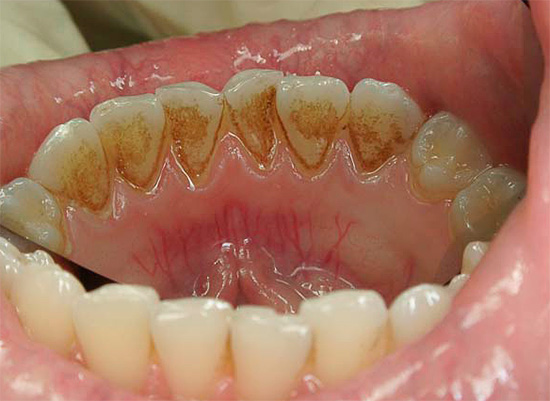
The most dangerous complications of pulpitis
The most dangerous complications of pulpitis occur on the background of prolonged pain or regular patience. taking pain pills. Most often, after pulpitis, acute or chronic periodontitis develops - inflammation of the tissues around the root.
With the acute form of periodontitis in most cases, people turn to a dental clinic for the reasonthat there are very strong throbbing pains, and it is simply impossible to touch the tooth, sometimes even the tongue. Often at the same time the body temperature rises and there is a feeling that the tooth seems to have “grown”. If a doctor is referred to it at this stage of the process, then after the tooth has been processed and penetrated into the area where the pulp should be located, an abundant pus with an unpleasant odor comes out of the canal.
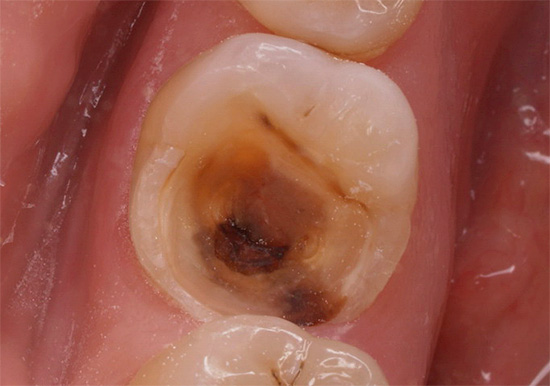
In chronic forms of periodontitis the most unpleasant are the formations on the gum - fistula. These are the channels that depart from the inflamed root of the tooth and from which periodically there is a foul-smelling pus that makes it easier for a person to suffer for the time being.
The most difficult to treat and dangerous to health is chronic periodontitis associated with the so-called cysts. Some people are well aware of the possible growth of tissues around the root in the form of granulomas and cysts, since they saw this picture after the removal of their tooth. These “purulent pouches” on the removed teeth hang from the roots, having a color ranging from red to bluish color. This picture leaves no one indifferent and is remembered for a long time.
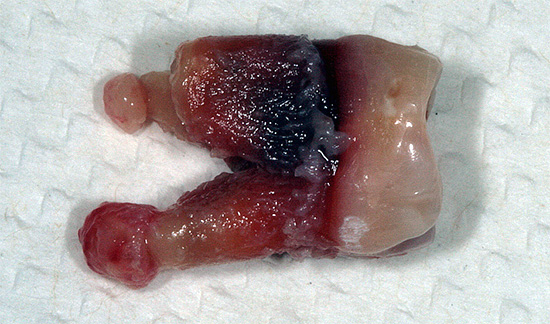
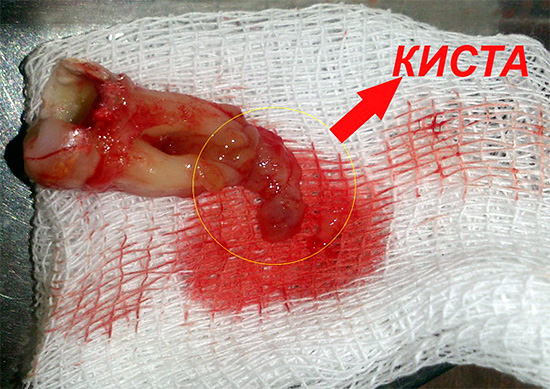
Read more about the formation of a cyst on the root of a tooth, its danger to health and possible complications during removal. separate article.
If you thought that this "horror" ends, you will have to disappoint. The above-mentioned complications of pulpitis were “peaceful” themselves, which most often lead only to tooth loss, but there are diseases that affect the general human health: periostitis, osteomyelitis, abscess, phlegmon, sepsis.
Periostitis is an inflammation of the jaw periosteum against the background of the spread of pus under it. As a result, the state of health worsens, the temperature rises to high values, the shape of the face may change, there is a feeling of distention in the gum near the patient's tooth. Often, after these serious conditions, a person more than once regrets that he did not treat relatively innocent pulpitis in time.
Osteomyelitis is the melting or dissolution of the bone, when the purulent process so covers the space of the jaw that, in addition to the diseased tooth, the teeth adjacent to it begin to loose.
On a note
With the long-term development of osteomyelitis, a person may seek the help of a dentist-surgeon to eliminate the source of infection, but the result of the removal of a diseased tooth can become a piece of jaw or fracture with it.Since in the process of progression of osteomyelitis, the bone becomes less durable due to its “dissolution”, even a small effort often leads to its injuries of varying severity.
Abscess (limited purulent inflammation) and phlegmon (diffuse purulent inflammation) are diseases that develop against the background of complications of pulpitis and often lead to death. They are associated with active germination of the source of infection in the space between the muscles where the vital formations (vessels, nerves) are located.
In the photo below - phlegmon:
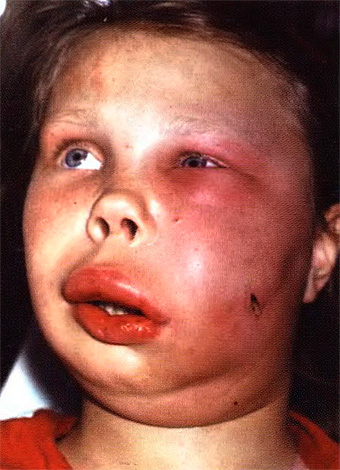
Sepsis is the contamination of the blood with toxic products of infection, leading to intoxication of the body, disruption of its defenses and, eventually, death.
How to independently recognize pulpitis
To prevent serious complications in time, it is useful to be able to recognize the pulpitis on its own at its very first symptoms. Diagnosing yourself is not so difficult.
In the event of the occurrence of toothaches, one should first of all understand their character: in case of caries, there is no acute spontaneous pain, it appears only from external stimuli. With acute pulpitis and its aggravation there are both of these signs.And in case of acute periodontitis, the tooth is most often not allowed to touch at all, the state of health may deteriorate, the hotter dramatically increases the already unbearable throbbing pain.
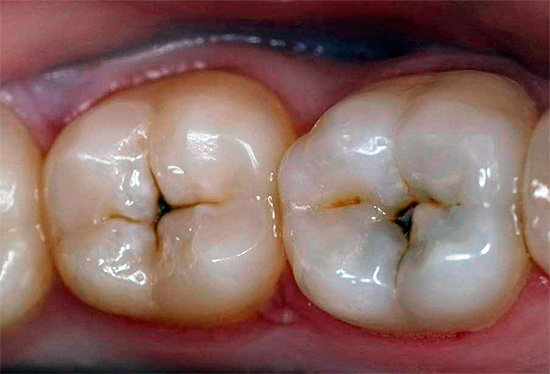
Chronic pulpitis is more difficult to detect, but with the possibility of examining the carious cavity, it becomes easier to recognize pulpitis. If the carious cavity is occupied by some kind of soft tissue, then, most likely, chronic hypertrophic pulpitis develops. If a long aching pain occurs when food gets into the tooth, then the likelihood of an open nerve is high, as with fibrous or gangrenous pulpitis.
Chronic periodontitis has much in common with chronic pulpitis, but only in chronic forms of periodontitis can there be fistulae on the gums near the patient's tooth. Only with periodontitis, the gum near the tooth can "swell up", hurt, and pus is often released from under it.
Despite the possibilities of self-diagnosis, the final diagnosis can only be made by a dentist, after conducting a set of diagnostic measures (examination, palpation, percussion, thermometry, EDI, X-ray).
The photo below shows the visiograph for radiography:
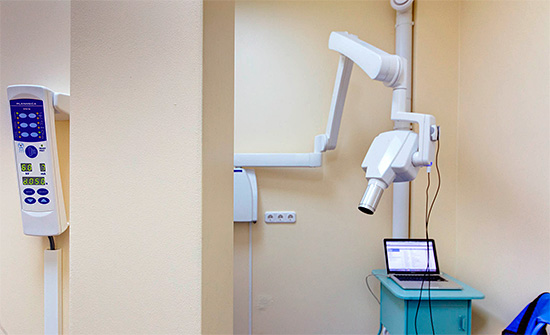
Treatment and prevention of pulpitis
After determining the pulpitis, the doctor draws up a plan for his treatment. There are 3 approaches to the treatment of pulpitis: with preservation of the entire “nerve”, with its partial removal, with complete extraction of the pulp from the system of the canal canals.
The first way to preserve the entire pulp in a viable state does not currently find popularity due to frequent complications, so doctors usually prefer the latter option. Partial removal of the pulp is also used, but only when it is not possible to go through the whole canal due to its complex structure or the presence of foreign bodies in it.
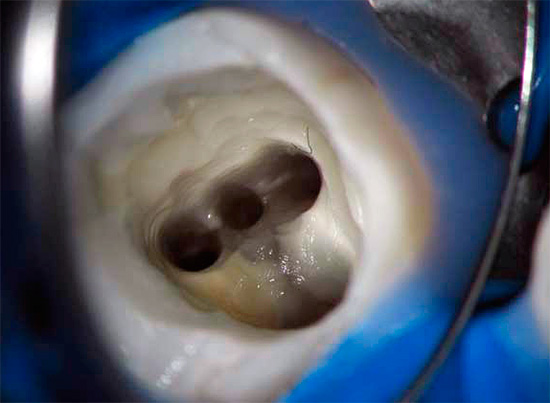
The main importance in the full treatment of pulpitis is a good medical treatment of the canals and their filling to the physiological apex (apex). For this, anesthesia is done, the channels are processed with special tools like needles (files), washed with antiseptic solutions and sealed with hardening pastes with gutta-percha pins or without them.
On a note
Often the treatment of pulpitis takes from 1-2 to 3-4 visits. This is connected with the approach to treatment, with or without the use of pastes for necrotization of the “nerve” (arsenic or not containing arsenic),with the production of special antiseptics or drugs for additional disinfection channels, designed for several days.

Read more about the interesting nuances of the treatment of pulpitis in the article. Modern methods of treatment of pulpitis.
Fine after the treatment of pulpitis should not be any pain. With limitations, post-filling pain is allowed after treatment for no more than 5-7 days, which only manifests itself as discomfort when biting on a tooth (especially solid food).
To prevent the development of pulpitis, timely treatment of caries that has arisen on the tooth is important. This is a minimum program. With regard to the maximum program, you should start prevention even before the occurrence of caries, and follow the recommendations aimed at strengthening the teeth and protecting them:
- To carry out cleaning with toothbrushes and toothpastes of all available surfaces of the teeth every time after eating;
- To clean the areas of the gaps between the teeth with floss (threads);
- Do not abuse the sweet;
- Perform professional hygiene 1 time in half a year (cleaning of plaque and stone);
- To carry out remineralization therapy and deep fluoridation of all teeth in consultation with the dentist.
The implementation of these recommendations will not only allow you to never feel the full horror of pulpit pain, but also protect your teeth from developing caries.
An interesting video about pulpitis
And here is the treatment of pulpitis
Root canal treatment

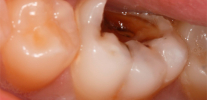

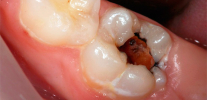
Very useful article. Thank!
Thanks for the useful information.
I'm terrified, I want to go to the dentist!
What a terrible picture of a boy.
Yes, I also finished playing with painkillers, then the floor of my cheeks was swollen + pus, removed along with the root and the partition. Take care of your teeth at an early age, and 2 times a year to check with a doctor!
Tomorrow to the doctor!
Yes, toothache - it's scary, I also took a tick on Tuesday. The tooth has been hurting for a week now, as if I have pulpitis, they are not joking with it.
Thank you for the article. Very helpful. Already running to the dentist, you never know)
Written in simple and understandable language without any scientific terms. Thank.
Yes, the trouble is our fear. But at the moment, medicine has become a successful and painless treatment of teeth, I am very glad about it. It also depends on the doctor, I got an excellent therapist, cured 11 teeth and there was no pain.
The therapist does not treat teeth, can only give direction.
Many thanks for the clear article with illustrations. Now I understand what is going on with my teeth. And when everything is clear, it is easier to make the right decision and not to wait for the alleged “pass itself.”
Well, how to make sure that your teeth do not hurt ...
Pull out.
Yesterday I was at the doctor’s office, I removed the inflamed nerve, cleaned three channels and put a temporary filling. Free, according to the policy! Thanks to the doctor and long healthy life!
I, it turns out, pulpitis. Inserted a seal, they said that it was necessary to complete the treatment. Well, let's hope that everything will be fine.
Thank you for the article. For the unknown - the worst thing)
Thanks, good article. Now I treat a tooth, but, unfortunately, already pulpit. I will never again delay the visit to the dentist, and to hell with the work, because of which there is no time to get to the doctor. And damn, sweet, however, it affects the teeth very much ...
Horrible. Urgent to the dentist.
I recently cured all my teeth, very grateful to our doctors. Take care of your teeth.
Could not expose such terrible photos!
Before reading, I did not think that everything would be serious, in a complex degree. Now I realized that tomorrow I need to go to the doctor ...
Thank! Very useful and interesting article.
Very sick half of the face. They put trigeminal neuralgia. The treatment did not work. Signs like pulpitis. We must go to the dentist. How to distinguish the disease?
Hello! It is important to assess the integrity of all teeth - the search for a causal tooth is determined both by painful sensations (where pain "shoots") and its appearance, which can vary greatly due to the destruction of caries. You did not write about whether X-ray or panoramic radiography was performed. Anyway, in your case careful diagnostics is required.
In the meantime, I will note only a couple of points for reflection. For trigeminal neuralgia characterized by: sharp paroxysmal pain that occurs when eating, talking. The pain does not occur at night.There is an increased sensitivity to palpation of the skin in places where certain nerves exit from the bones of the skull. But with pulpitis (diffuse, which is just manifested by radiating pain), on the contrary, pain often occurs at night, and in the mouth there are “suspicious” teeth, which often have destroyed surfaces. In addition, with pulpitis, there is no pain associated only with communication with people when active facial expressions are present.
So you definitely should go to the dentist.
Thank you very much for the useful information!